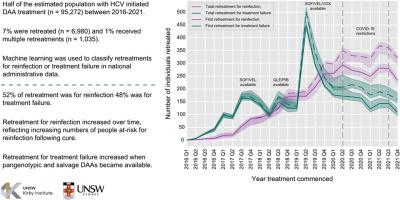Journal of Hepatology ( IF 25.7 ) Pub Date : 2022-09-22 , DOI: 10.1016/j.jhep.2022.09.011 Joanne M Carson 1 , Sebastiano Barbieri 2 , Gail V Matthews 1 , Gregory J Dore 1 , Behzad Hajarizadeh 1

|
Background & Aims
Population-level uptake of direct-acting antiviral (DAA) treatment for hepatitis C virus (HCV) infection, including retreatment, can be estimated through administrative pharmaceutical dispensation data. However, the reasons for retreatment are not captured in these data. We developed a machine learning model to classify retreatments as reinfection or treatment failure at a national level.
Methods
Retreatment data from the REACH-C cohort (n = 10,843 treated with DAAs; n = 320 retreatments with known reason), were used to train a random forest model. Nested cross validation was undertaken to assess model performance and to optimise hyperparameters. The model was applied to data on DAA retreatment dispensed during 2016-2021 in Australia, to identify the reason for retreatment (treatment failure or reinfection).
Results
Average predictive accuracy, precision, sensitivity, specificity and F1-score for the model were 96.3%, 96.5%, 96.3%, 96.3% and 96.3%, respectively. Nationally, 95,272 individuals initiated DAAs, with treatment uptake declining from 32,454 in 2016 to 6,566 in 2021. Of those treated, 6,980 (7%) were retreated. Our model classified 51.8% (95% CI 46.7–53.6%; n = 3,614) of cases as reinfection and 48.2% (95% CI 46.4–53.3%; n = 3,366) as treatment failure. Retreatment for reinfection increased steadily over the study period from 14 in 2016 to 1,092 in 2020, stabilising in 2021. Retreatment for treatment failure increased from 73 in 2016 to 1,077 in 2019, then declined to 515 in 2021. Among individuals retreated for treatment failure, 50% had discontinued initial treatment.
Conclusions
We used a novel methodology with high classification accuracy to evaluate DAA retreatment patterns at a national level. Increases in retreatment uptake for treatment failure corresponded to the availability of pangenotypic and salvage regimens. Increasing retreatment uptake for reinfection likely reflects increasing reinfection incidence.
Impact and implications
This study used machine learning methodologies to analyse national administrative data and characterise trends in HCV retreatment due to reinfection and treatment failure. Retreatment for reinfection increased over time, reflecting increasing numbers of people at risk for reinfection following HCV cure. Increased retreatment for treatment failure corresponded to the availability of pangenotypic and salvage DAA regimens. The findings of this study can be used by public health agencies and policy makers to guide and assess HCV elimination strategies, while the novel methodology for monitoring trends in HCV retreatment has the potential to be used in other settings, and health conditions.
中文翻译:

澳大利亚因再感染或治疗失败导致 HCV 再次治疗的全国趋势
背景与目标
可以通过行政药品配药数据估计人口水平对丙型肝炎病毒 (HCV) 感染的直接作用抗病毒 (DAA) 治疗(包括再治疗)的使用情况。然而,这些数据中并未包含再治疗的原因。我们开发了一个机器学习模型,在全国范围内将再治疗分类为再感染或治疗失败。
方法
来自 REACH-C 队列的再治疗数据(n = 10,843 接受 DAA 治疗;n = 320 名已知原因再治疗)用于训练随机森林模型。进行嵌套交叉验证以评估模型性能和优化超参数。该模型应用于澳大利亚 2016-2021 年分发的 DAA 再治疗数据,以确定再治疗的原因(治疗失败或再感染)。
结果
该模型的平均预测准确度、精确度、灵敏度、特异性和 F 1分数分别为 96.3%、96.5%、96.3%、96.3% 和 96.3%。在全国范围内,有 95,272 人开始了 DAA,接受治疗的人数从 2016 年的 32,454 人下降到 2021 年的 6,566 人。在接受治疗的人中,有 6,980 人 (7%) 撤退了。我们的模型将 51.8%(95% CI 46.7–53.6%;n = 3,614)的病例分类为再感染,将 48.2%(95% CI 46.4–53.3%;n = 3,366)的病例分类为治疗失败。在研究期间,再感染再治疗从 2016 年的 14 人稳步增加到 2020 年的 1,092 人,并在 2021 年趋于稳定。因治疗失败而再治疗的人从 2016 年的 73 人增加到 2019 年的 1,077 人,然后在 2021 年下降到 515 人。在因治疗失败而再治疗的个体中, 50% 已停止初始治疗。
结论
我们使用了一种具有高分类准确性的新方法来评估国家层面的 DAA 再治疗模式。治疗失败的再治疗吸收增加与泛基因型和补救方案的可用性相对应。再感染再治疗的增加可能反映了再感染发生率的增加。
影响和启示
本研究使用机器学习方法来分析国家行政数据,并描述因再感染和治疗失败导致的 HCV 再治疗趋势。再感染的再治疗随着时间的推移而增加,反映出越来越多的人在 HCV 治愈后面临再感染的风险。治疗失败的再治疗增加与泛基因型和补救 DAA 方案的可用性相对应。公共卫生机构和政策制定者可以使用这项研究的结果来指导和评估 HCV 消除策略,而监测 HCV 再治疗趋势的新方法有可能用于其他环境和健康状况。



























 京公网安备 11010802027423号
京公网安备 11010802027423号